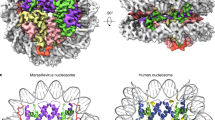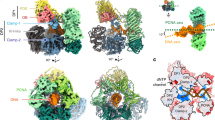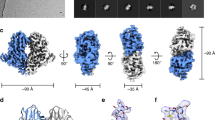Abstract
Two new polypeptides of molecular weights 75,000 and 45,000 are found in KB cells infected with human adenovirus type 2 (Ad 2), (ref 1). They represent the major labelled protein components of a nuclear membrane fraction (‘DNA replication complex’) that is capable of synthesising adenovirus DNA in vitro1–3. It has been proposed that these polypeptides are early viral gene products, for they are synthesised soon after infection in the presence of 1-β-D-arabinosylcytosine (Ara C), an inhibitor of DNA synthesis1. Their association with the DNA replication complex suggested that they may have an affinity for DNA and could play a role in the replication of adenovirus DNA. It was subsequently shown that these two polypeptides bind strongly to single-stranded DNA–cellulose columns and that large amounts of these ‘DNA-binding proteins’ can be isolated from the cytoplasm of the infected cells2. Two polypeptides of similar molecular weights (72,000 and 48,000) were independently isolated from cell extracts of monkey kidney cells, abortively infected with Ad 5, by their ability to bind to single-stranded DNA-cellulose4,24. The use of temperature-sensitive mutants of Ad 5 indicated that these polypeptides are viral-coded4,24. Comparison of tryptic maps suggested that the 48,000 component was a degradation product of the 72,000 polypeptide (A. J. Levine, unpublished). A polypeptide of molecular weight about 65,000–75,000 has also been detected by polyacrylamide gel analysis in KB cells soon after infection by Ad 2 and Ad 5 (refs 5–7) and in HeLa cells infected by Ad 2 (ref. 8).
This is a preview of subscription content, access via your institution
Access options
Subscribe to this journal
Receive 51 print issues and online access
$199.00 per year
only $3.90 per issue
Buy this article
- Purchase on Springer Link
- Instant access to full article PDF
Prices may be subject to local taxes which are calculated during checkout
Similar content being viewed by others
References
Yamashita, T., and Green, M., J. Virol., 14, 412–420 (1974).
Shanmugam, S., Bhaduri, S., Arens, M. Q., and Green, M., Biochemistry, 14, 332–337 (1975).
Yamashita, T., Arens, M. Q., and Green, M., J. biol. Chem. (in the press).
van der Vliet, P. C., and Levine, A. J., Nature new Biol., 246, 170–174 (1973).
Russel, W. C., and Skehel, J. J., J. gen. Virol., 15, 45–57 (1972).
Anderson, C. W., Baum, P. R., and Gesteland, R. F., J. Virol., 12, 241–252 (1973).
Bablanian, R., and Russel, W. C., J. gen. Virol., 24, 261–279 (1974).
Walter, G., and Maizel, J. V., Jr, Virology, 57, 402–408 (1974).
Green, M., A. Rev. Biochem., 39, 701–756 (1970).
Freeman, A. E., et al., Proc. natn. Acad. Sci. U.S.A., 58, 1205–1212 (1967).
Graham, F. L., Van der Eb, A. J., and Heijneker, H. L., Nature, 251, 687–691 (1974); Graham, F. L., et al., Cold Spring Harb. Symp. quant. Biol., 39 (in the press).
Gallimore, P. H., Sharp, P. A., and Sambrook, J., J. molec. Biol., 89, 49–72 (1974).
Litman, R. M., J. biol. Chem., 248, 6222–6233 (1968).
Maizel, J. V., Jr, in Fundamental Techniques in Virology (edit. by Habel, K., and Salzman, N. P.), 334–362 (Academic, New York and London, 1969).
Green, M., and Pina, M., Proc. natn. Acad. Sci. U.S.A., 15, 1251–1259 (1964).
Prage, L., Pettersson, V., and Phillipson, L., 36, 508–511 (1968).
Sever, J. L., J. Immun., 88, 320–329 (1962).
Horwitz, M. S., and Scharff, M. D., in Fundamental Techniques in Virology (edit. by Habel, K., and Salzman, N. P.),297–315 (Academic, New York and London, 1969).
Fahey, J. L., and Terry, E. W., in Handbook of Experimental Immunology (edit. by Wein, D. M.), 19–43 (Davis, Philadelphia, 1967).
Büttner, W., Veres-Molnar, Z., and Green, M., Proc. natn. Acad. Sci. U.S.A., 71, 2951–2955.
Alberts, B. M., and Frey, L., Nature, 227, 1313–1318 (1970).
Wall, R., Weber, J., Gage, Z., and Darnell, J. E., J. Virol., 11, 953–960, 1973.
Carroll, R. B., Hager, L., and Dulbecco, R., Proc. natn. Acad. Sci. U.S.A., 71, 3754–3757 (1974).
van der Vliet, P. C., Levine, A. J., Ensinger, M. J., and Ginsburg, H. S., J. virol., 15, 348–354 (1975).
Author information
Authors and Affiliations
Rights and permissions
About this article
Cite this article
GILEAD, Z., ARENS, M., BHADURI, S. et al. Tumour antigen specificity of a DNA-binding protein from cells infected with adenovirus 2. Nature 254, 533–536 (1975). https://doi.org/10.1038/254533a0
Received:
Published:
Issue Date:
DOI: https://doi.org/10.1038/254533a0
This article is cited by
Comments
By submitting a comment you agree to abide by our Terms and Community Guidelines. If you find something abusive or that does not comply with our terms or guidelines please flag it as inappropriate.



